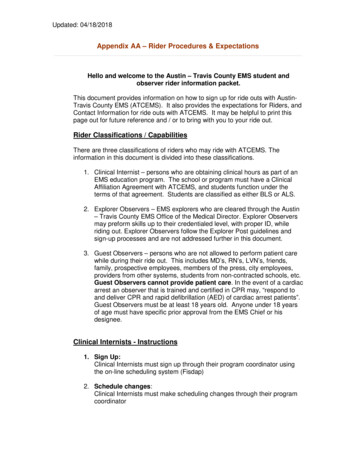
Transcription
Chapter 99-01Total Station System (TSS)Survey SpecificationGeneralSurvey specifications describe the methods and procedures needed to attain the desiredsurvey standard. Specifications in the section are based on Federal Geodetic ControlSubcommittee (FGCS) standards and specifications. Except where noted, they havebeen modified to give results that will meet the standards for various TSS surveystypically performed by WSDOT. For complete standards, refer to Chapter 7, “AccuracyClassifications and Standards”.WSDOT TSS survey specifications are to be used for all WSDOT involved transportationimprovement projects, including special-funded projects.9-02The TSS MethodThe TSS is a system that includes an electronic total station and electronic data collectingsystem. Conventional survey methods of traverse, network, resection, multiple ties andtrigonometric leveling are used with the TSS method. Each WSDOT field survey crew isequipped with a TSS. The basic specifications for the WSDOT TSS are: Angle measurement:6” accuracy, (Standard deviation 1”)Distance measurement: /- (0.01 ft (3 mm) 3 ppm) in standard mode Data Controller:WSDOT standard data controller and with softwarecompatible with WSDOT’s design and survey software. PC Software:WSDOT’s current supported softwareThe system also includes tripods, tribrachs, prisms, targets and prism poles.For specific questions about the use of the software, see the programs Manual availableon-line or the WSDOT software training manuals.The specifications included in this Section are based on the basic WSDOT TSS. If otherTSS are used, those specifications might not be applicable.All TSS equipment must be properly maintained and regularly checked for accuracy.Equipment repair, adjustment, and maintenance are covered in Chapter 3, “Equipment.”9-039-03.1General TSS Survey SpecificationsRedundancyWhen proper procedures are followed, the WSDOT TSS generally can easily meet theaccuracy standards for WSDOT second order, third order and general order surveys. Forexample, the WSDOT TSS instrument specifications indicate that angles observed onetime will meet the required accuracy standards, but without redundancy of observations,the possibility of blunders exist. For this reason, a complete set of angles is observed(two pointings to the backsight and two pointings to the foresight, minimum) wheneverestablishing or tying existing critical points such as control points and cadastral points.Redundant observations such as multiple ties are observed, whenever feasible, to improvethe information available from least squares adjustments to strengthen survey networks.Highway Surveying ManualJanuary 2005Page 9-1
Total Station System (TSS) Survey Specification9-03.2Equipment ChecksCheck total station vertical index and horizontal collimation each day.Systematic errors due to poorly maintained equipment must be eliminated to ensure validsurvey adjustments. Regularly check and adjust optical plummets, tribrachs, tripods, andleveling bubbles. For barometers and thermometers, check regularly for accuracy.9-03.3Set UpHeight of instrument and target: Measure and enter the H.I. and H.T. into thedata controller at the beginning of each set up. It is advisable to check the target andinstrument heights at the completion of each set up along with the optical plummet’sposition over the point.Temperature and barometric pressure: Measure and enter the appropriate partsper million (ppm) correction into the data controller before work each day for generalorder and third order surveys. For second order surveys, make temperature and pressurereadings and enter ppm correction into the data controller again at midday. Each 34 F(1 C) change in temperature will cause a one-ppm error, if the ppm setting in the datacontroller is not changed.Checking: After setting the instrument up, measure the distance to the backsight toprovide a check. Observations of other known points are encouraged whenever practical.For general order surveys, it is good practice to observe selected points from two setupsas a check. At the conclusion of each setup, re-observe the direction to the backsight. Forgeneral order surveys (construction staking, topographic surveys, etc.), where areas aresurveyed from two different setups, have common points from the two setups to provideadditional checks.Mode: All distance observations for second order and third order surveys are taken instandard measurement mode on the total station. Distances for general order surveys maybe taken in track mode.9-03.4Field NotesOriginal survey notes, for all TSS observations, are maintained in the data controllerand are stored electronically. Data controller headers must be completely filled in. Addcomments about observations that might affect data reduction to the data controllerfile with a text entry. Data for all points that will be used as control and any cadastralmonuments must be collected with 2 pointings in the data controller to be incorporatedinto a least squares adjustment.Supplement the data controller notes with hand written notes. At a minimum, thesenotes include setup information (point numbers, codes, measure ups,), sketches, detaileddescriptions and/or rubbings of monuments as appropriate and other general commentsabout the survey. Field notes are not complete unless they contain the date, project nameand/or number, page number, and crew names.9-03.5Survey AdjustmentsAll control points used for data gathering and stake out, including photo control, areadjusted by the method of least squares. Control points established by resection methodsare adjusted for horizontal position by least squares before they are used in the field.Page 9-2Highway Surveying ManualJanuary 2005
Total Station System (TSS) Survey Specification9-049-04.1Second Order SurveysApplicationsCorridor Control: TSS can be used to perform second order trigonometric levelingsurveys for Corridor Control Surveys.Project Control: TSS can be used for horizontal and vertical Project Control Surveys todensify project control established by GPS.9-04.2Horizontal SpecificationsMethod: Traverse with cross ties. Figure 9-1 lists the specifications required to achievesecond order horizontal accuracy.9-04.3Vertical SpecificationsMethod: Trigonometric Leveling, a method by which differences in elevation aredetermined by measuring vertical angles and slope distances.Trig leveling is a separate and different procedure than carrying elevations withconventional total station traversing. The total station is setup anywhere convenient justlike a level and there is no measure up at the instrument. There is no requirement forbalanced sight lengths, and differences in elevation of 60 feet or more between backsightand foresight in one setup are not uncommon in steep terrain. The key to success isredundant elevation differences to fixed height targets.Figure 9-2 lists the specifications required to achieve second order vertical accuracy.Highway Surveying ManualJanuary 2005Page 9-3
Total Station System (TSS) Survey SpecificationSpecificationsTraverse/NetworkCheck vertical index errorDailyCheck horizontal collimationDailyMeasure instrument height and target heightBegin and end each setupUse optical plummet to check position of target and instrumentover pointsBegin and end each setupMeasure temperature and pressure and enter ppm correction intototal stationFirst set-up, midday setupMeasure distance to backsight and foresight at each setupObserve traverse multiple ties to improve least squares adjustmentRequiredRequired, as feasibleClose all traversesRequiredHorizontal angle observations3D, 3R (2 set) minimumVertical angle observations3D, 3R (2 set) minimumAngular rejection limit, i.e., reject angle if difference compared tomean of observations is greater than5”Minimum distance measurement330 ftSecond order (Horizontal) TSS Survey SpecificationsFigure 9-1SpecificationsTrigonometric LevelingCheck vertical index error4 times per dayUse fixed height staff for targetRequiredMeasure temperature and pressure and enter ppm correction intototal stationVertical angle observationsFirst setup, midday setup2 sets of 2D, 2R (See Note)Angular rejection limit, i.e., reject angle if difference compared tomean of observations is greater than10”Measure uncorrected zenith distanceEach pointingMeasure uncorrected slope distanceEach pointingDifference between two differences in elevation for each setup notto exceed0.005 ftMaximum sight length700 ftMinimum ground clearance of line of sight3 ftNote:Two sets (eight pointings); each set of observations (2D, 2R) yields an independent difference in elevationbetween the backsight and foresight.Second order (Vertical) TSS Survey SpecificationsFigure 9-2Page 9-4Highway Surveying ManualJanuary 2005
Total Station System (TSS) Survey Specification9-05Third Order Surveys (Tertiary)TSS can be used for both third order horizontal and vertical positioning.9-05.1Applications Supplemental control surveys for construction and engineering surveys Photogrammetric control Cadastral Location control Monumentation control Major structure and interchange stakingSupplemental control points are points that will be used as setup points to gathertopographic data, locate monuments, perform Construction Staking and setout othercontrol and right of way monuments.9-05.2SpecificationsMethods: Traverse Resection: This method locates the unknown position of a setup point byobserving known positions from the unknown point. Generally, points are resectioned by observing three known points of equal or greater accuracy. Two pointresections may be acceptable if the angle between the observed points is less than135 degrees or greater than 225 degrees. All specifications for third order must bemet. Figure 9-3 lists the specifications required to achieve third order accuracy.Highway Surveying ManualJanuary 2005Page 9-5
Total Station System (TSS) Survey SpecificationTraverse/NetworkResection Double TieSpecificationsCheck vertical index errorDailyCheck horizontal collimationDailyBegin and end each setupMeasure instrument height and target heightUse optical plummet to check position of target and instrument overpointsEnd of each setupMeasure temperature and pressure and enter ppm correction into totalstationFirst set-up of dayMeasure distance to backsight and foresight at each setupObserve traverse multiple ties to improve least squares adjustmentClose all traversesRequiredAs feasibleRequiredNumber of known points to observeN/AHorizontal angle observations2D, 2R (1 set) minimumVertical angle observations2D, 2R (1 set) minimumAngular rejection limit, i.e., reject angle if difference compared to meanof observations is greater than10”Minimum distance measurement to meet horizontal standard165 ftMaximum distance measurement to meet vertical standard330 ftThird-Order TSS Survey SpecificationsFigure 9-39-06General Order Surveys9-06.19-06.2Applications Engineering survey collected topographical data Construction survey, staked points GIS surveys Environmental surveysSpecificationsThe radial survey method is used for all General Order surveys. Data for General Orderpoints are gathered as radial observations in the data controller and are not available forleast squares adjustment.For construction staking, staked positions are rejected, when the difference betweenthe “set” (observed) position and the theoretical design position exceeds the allowabletolerances.Engineering survey data points are checked by various means including reviewingthe digital terrain model, reviewing digital terrain lines in profile, and redundantmeasurements to some points from more than one setup.Page 9-6Highway Surveying ManualJanuary 2005
Total Station System (TSS) Survey SpecificationFigure 9-4 lists the specifications required to achieve General Order accuracy.SpecificationsRadialCheck vertical index errorDailyCheck horizontal collimationDailyMeasure instrument height and target heightYesUse optical plummet to check position of target and instrument overpointsBegin and end each setupMeasure temperature and pressure and enter ppm correction into totalstationFirst set-up of dayHorizontal angle observations1DVertical angle observations1DMinimum distance measurement to meet horizontal standard65 ftMaximum distance measurement to meet vertical standard500 ftGeneral-Order TSS Survey SpecificationsFigure 9-4Highway Surveying ManualJanuary 2005Page 9-7
Total Station System (TSS) Survey SpecificationPage 9-8Highway Surveying ManualJanuary 2005
compatible with WSDOT's design and survey software. PC Software: WSDOT's current supported software The system also includes tripods, tribrachs, prisms, targets and prism poles. . between the backsight and foresight. Second order (Vertical) TSS Survey Specifications Figure 9-2. Page 9-4 Highway Surveying Manual January 2005 Total .











